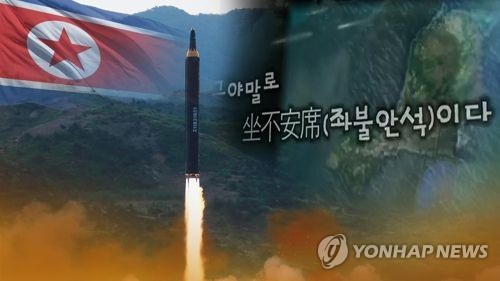
The missile was fired eastward from the vicinity of Sunan in Pyongyang at around 5:57 a.m., according to South Korea's Joint Chiefs of Staff (JCS).
"It passed through the sky over Japan" and fell into the North Pacific Ocean, the JCS said.
It added the projectile, presumed to be an intermediate-range ballistic missile (IRBM), flew more than 2,700 kilometers at a maximum altitude of around 550 km.
It was the North's 13th ballistic missile fired this year alone.
The U.N. Security Council decided to hold an emergency meeting in New York later in the day on punitive steps.
In a statement, the South Korean government strongly condemned the North for the latest missile launch and urged it to choose the path of denuclearization, not such a "reckless provocation."
South Korean President Moon Jae-in ordered his troops to demonstrate the capability for "strong retaliation" as his office Cheong Wa Dae immediately convened a National Security Council (NSC) session.
Foreign Minister Kang Kyung-wha telephoned U.S. Secretary of State Rex Tillerson on the North Korea issue. They expressed "deep disappointment" over Pyongyang's move that went against potential talks.
Top South Korean and U.S. military officers also discussed "military and strategic responses" to Pyongyang's move in a phone conversation.
Gen. Jeong Kyeong-doo, chairman of South Korea's Joint Chiefs of Staff, and his American counterpart Gen. Joseph Dunford agreed to take related measures at the earliest possible date, which apparently include the temporary dispatch of U.S. strategic assets like long-range bombers to Korea.
Four F-15K fighter jets of South Korea conducted a live-bombing drill aimed at removing the North's leadership in case of an emergency situation, the Air Force said.
The state-run Agency for Defense Development released footage of its recent testing on new ballistic missiles in a warning against the North.
It's quite unusual for the secretive North to fire a ballistic missile from its capital, another sign that it's diversifying launch areas to dodge external surveillance and a possible pre-emptive strike.
The Pentagon confirmed that the North's missile flew over Japan's territory.
"We are still in the process of assessing this launch. North American Aerospace Defense Command (NORAD) determined the missile launch from North Korea did not pose a threat to North America," Pentagon spokesman Army Col. Rob Manning said in a statement.
It's not the first time that Pyongyang has sent a missile over Japan. The previous case took place in 2009.
Japan's Chief Cabinet Secretary Yoshihide Suga told a press briefing that the missile flew over Cape Erimo on the northern island of Hokkaido before dropping into waters 1,180 km east of the area.
He described it as a serious and grave threat to his country, as the government offered related information via its J-Alert system.
Defense officials here bet on the possibility that the missile is a Hwasong-12 IRBM, a source said, as they have noted that it was fired on a standard trajectory.
A Hwasong-12 missile the North launched at a lofted angle in May traveled some 780 km at an apogee of roughly 2,110 km. It means a range of 4,500-5,000 km if fired at a normal angle.
The North appears to be trying to show off its capability of striking major U.S. military facilities in Japan and Guam, and protesting the allies' combined military exercise, called the Ulchi Freedom Guardian (UFG), a JCS official told reporters in a background briefing.
The North has often used the allies' military drills as a pretext for provocations.
The North's provocation is another slap in the face to the left-leaning South Korean leader and U.S. President Donald Trump as they have sought to resume dialogue.
Last weekend, the North launched three projectiles that the allies determined were short-range ballistic missiles.
The latest missile launches marked an end to a monthlong hiatus in the Kim Jong-un regime's provocations, which U.S. officials described as "restraint."
Trump said last week the North's leader "is starting to respect us."
On Sunday, Tillerson also said despite the North's firing of three short range missiles, "We're going to continue our peaceful pressure campaign, as I have described it, working with allies and working with China as well to see if we can bring the regime in Pyongyang to the negotiating table with a view to begin a dialogue on a different future for the Korean Peninsula and for North Korea."
Weeks ago, the North threatened to shoot four missiles toward Guam that would travel over three southern Japanese prefectures, but it backed off later, saying it would wait and see the U.S. attitude.
The South's intelligence community said Monday the North appears all set to conduct a nuclear test at its Punggye-ri test site.
The North will celebrate its founding anniversary Sept. 9.
























